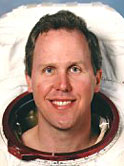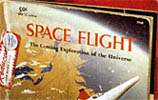|
Tom Jones
–
astronaut
|

|
"
She got it on the bargain table at the five and ten for only 25 cents,
but this little book changed the course of my young life."
|

|
| |
|
|
|
| |
How were you originally motivated to become an astronaut? |
| |
My first step toward flying in space was really a shove from behind! In
1960, when I was five years old, my grandmother, Mary Jones, gave me a slim
volume from the "Golden Book of Knowledge" series called Space Flight: The
Coming Exploration of the Universe. She got it on the bargain table at the
five and ten for only 25 cents, but this little book changed the course of
my young life. The book's fantastic paintings laid out a plan for the human
exploration of space, and eventual visits to the Moon and planets.
Paintings of the new rockets then being built were accompanied by others
showing what the strange experience of spaceflight might be like. Little
did my grandmother imagine where her little gift would one day take me. I
suspect my mother has never quite forgiven her.
While in elementary school in Essex, Maryland (just east of Baltimore), the
space age was taking off. In fifth and sixth grade we were watching the
first of the Gemini missions take flight. I was just 10, but I remember how
important these early spaceflights were to the teachers, parents, and
country at large. For each of these two–man Gemini voyages –– we were
working out how we would go to the moon and practicing each step –– my
class would stop our schoolwork and watch the countdown and blast–off on a
TV that a parent had brought into the classroom. I would draw sketches of
the rockets, the capsules, and the mission activity, and then squirrel them
away in my notebook. A few days later, we would repeat the process and wait
for a successful splashdown; the tension of not knowing whether the capsule
would appear safely under its parachute was always present. With each
mission's success, we were a step closer to reaching the Moon.
One memorable weekend, my Cub Scout den trooped to an open house at the
Martin (aircraft) Company's plant, just a couple of miles from my house.
The jaw–dropping sight of two 90–foot Titan boosters, being readied to hurl
Gemini astronauts into orbit, made a huge impression on me. Here was space
exploration formed from sculpted metal, and it was happening right in my own
hometown!
These two years of Gemini spaceflights, soaring above while I mentally
prepared for the jump to high school, made the difference in my life. I
decided that the job title of "Astronaut" had tremendous appeal for me. It
combined the thrill of exploration (of going to new, untouched places) with
demanding flying skills (and I'd been in love with flying and airplanes
since I was old enough to look up at the sky). So by the age of ten I knew
I'd like to try for that job one day, and I decided to use my schoolwork to
get me there.
Just three years later, during the summer of 1969, my career aspirations
were reinforced by the amazing achievement of our first Moon landing.
Nothing could have impressed me more than seeing the culmination of all our
spaceflight efforts of the 1960s in the first steps of Neil Armstrong on
another world. When he and Mike Collins and Buzz Aldrin returned to Earth,
I knew I would be trying, after graduation, for a job as an Air Force pilot,
then the first step on the road to Astronaut. At the same time, I was
taking every science course in sight, trying to prepare for college studies
in the space sciences. Those Apollo footsteps forged a clear path for
me to
follow.
|
|

|
| |
|
|
|
| |
What qualities are important in becoming a first-class astronaut? |
| |

|
|
An astronaut makes a conscious choice to repeatedly venture into a harsh
environment to gain new knowledge. He or she must confont the fact that
the risks of spaceflight are real and ever–present. With full knowledge
of those cold realities, one must still perform to exacting standards,
maintaining a level
of professionalism commensurate with the great privilege of flying into
space on behalf of thousands of fellow explorers.
I'm always aware of the many thousands, if not millions, of kindred spirits
who accompany me vicariously on each mission I'm privileged to fly. That
sense of representing others, of living the dreams of those who would
instantly step willingly off the planet with me, keeps me focused on the
larger responsibility I've been given.
To live up to those dreams and spark those imaginations, an astronaut must
commit totally to excellence. Our moments in space are precious, so
valuable, that the crewmembers must be prepared to execute the mission as
well as humanly possible. This standard requires exacting attention to
detail, and a willingness to pursue problems to their final resolution.
Astronauts must be dogged in their determination to succeed. And it starts
with winning the job! I was turned down twice by NASA before finally
gaining a job interview in 1989.
Spaceflight today is a "people" job. An astronaut must have drive and
ambition, certainly, but not for personal gain. A good astronaut takes that
determination to succeed and channels it toward the success of the TEAM –
the crew. Teamwork is what we really respect, and good teamwork is a
joy to
experience. All share the work and pain of months – even years – of
preparation for each flight; all share the satisfaction and pride in a
mission done well.
The only unsuccessful astronauts I've known were those very few who thought
the mission was about making themselves look good, who saw spaceflight
as an
opportunity to advance their own status and reputation. They made the job
harder for their crewmates, who had to pick up the work left undone by
someone pushing in a different direction. Such a crewmember, pursuing a
private agenda, would be a potential disaster on a Mars mission.
Spaceflight, either on the space station or on a voyage to Mars, demands
cooperation and practiced, selfless teamwork. We need people who practice
the skill of getting along with others, who submerge their own interests in
the team's success, and who offer their own talents in support of the crew's
collective capabilities. Exceptional teamwork is the minimum standard in
spaceflight – it can literally be a matter of life and death.
In working with the team, an astronaut must be forthright and outspoken in
communicating with others. Problems must be confronted directly, attacked
vigorously, and solved promptly. Misunderstandings between crewmembers,
or between a crew and mission control, have occurred in spaceflight, and they
can only be avoided on Mars missions by clear, straightforward
communication.
Finally, an astronaut at the end of this century must be a dreamer. We've
remained in Earth orbit for more than a quarter of a century; in the new
millennium, we need colleagues with the enthusiasm to take us outward once
again, who can envision astronauts working on the new space station,
returning to an outpost on the Moon, exploring the asteroid swarm near
Earth, and establishing a settlement on Mars. That imagination must have
the patience to see hard work pay off, to see the dream realized. I labor
now in the "trenches" of low Earth orbit with the hope of one day following
the Apollo explorers who inspired me.
|
|
| |
|
|
|
| |
What ideas can you suggest for a future human community on Mars?
|
| |
(a) Exploit near–Earth asteroids to provide raw materials that create
space–based supplies of propellant and life–support consumables. Water is
present on many main–belt asteroids, and is undoubtedly a component of the
thousands of smaller fragments that approach the Earth–moon system.
(b) Develop nuclear propulsion systems to reduce trip times between
Mars and Earth, and to reduce the amount of propellant needed for Mars travel.
(c) Develop compact, safe nuclear power systems to provide reliable surface
power to a Mars colony. Successful growth of the settlement depends on an
energy–rich environment.
(d) Establish a high–capacity communications network between Mars and
Earth, not in support of a rigid command structure run from Earth, but
to enable humans to experience "virtual" environments on both planets.
Such shared experiences will strengthen cultural links and make
information one of the most valuable products returned from Mars to Earth.
(e) Let commercial enterprises develop an economical and robust
transportation architecture in Earth–Moon space, using space resources and
innovative launch systems. That web of business and transportation
activities will support the initial voyages to Mars and enable rapid
expansion of the settlement once humans establish a Mars outpost.
Space Station Image Gallery
http://spaceflight.nasa.gov/gallery/images/station/index.html
Space Station Assembly Mission 5A
http://station.nasa.gov/station/assembly/flights/5a.html
Thomas D. Jones biographical data:
http://www.jsc.nasa.gov/Bios/htmlbios/jones.html
Live video from the Space Station Processing Facility at Kennedy Space
Center
http://www.ksc.nasa.gov/payload/missions/station/sspf-video.html
NASA International Space Station Home Page
http://station.nasa.gov/station/index.html
|
|

|
|




